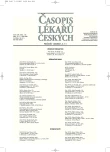Changes of Plasminogen Activator Inhibitor (PAI-1) During Estrogen Replacement Therapy
Změny hladin inhibitoru aktivace plazminogenu (PAI-1) v průběhu estrogenní substituční terapie
Východisko.
Cílem studie bylo zjistit změny plazminogen activator inhibitor – 1(PAI-1) jako biochemického rizikového faktoru pro kardiovaskulární nemoci při různých aplikačních formách časně zahájené estrogenní substituční terapie.
Metody a výsledky.
V prospektivní randomizované 12týdenní intervenční studii byl v cross-over designu podáván estradiol perorálně v dávce 2 mg denně nebo transdermálně v dávce 0,05 mg denně. Zařazeno bylo 45 zdravých postmenopauzálních žen do 12 týdnů od odstranění dělohy a vaječníků (chirurgické kastrace). Studii dokončilo 41 žen a jejich data byla analyzována. Průměrný věk byl 49±6 let. PAI-1 bylo stanoveno bio imunoassay (ChromolyzeTM PAI-1). Po perorální estrogenní terapii hladina PAI-1 signifikantně (p=0,001) klesla z 11,39±12,02 IU/l na 5,0±5,27 IU/l. Tyto změny jsou významné i ve srovnání s nesignifikantními změnami po transdermální léčbě.
Závěry.
Perorální terapie významně snížila hladiny PAI-1 ve srovnání s transdermální. Tyto změny jsou z pohledu kardiovaskulárního rizika příznivé.
Klíčová slova:
estrogenní substituční terapie, kardiovaskulární riziko, PAI-1.
Authors:
Z. Žižka; Tomáš Fait
; M. Vráblík 1
Authors‘ workplace:
Gynekologicko-porodnická klinika 1. LF UK a VFN, Praha
; III. interní klinika 1. LF UK a VFN, Praha
1
Published in:
Čas. Lék. čes. 2007; 146: 874-877
Category:
Original Article
Overview
Background.
The purpose of the present study was to determine changes of plasminogen activator inhibitor – 1 (PAI-1) as biochemical cardiovascular risk factor during the use of different administration methods in the early estrogen replacement therapy.
Methods and Results.
In a 12-week prospective, randomized, interventional, cross-over trial, oestradiol was administered orally in a dose of 2 mg daily or transdermally in a dose of 0.05 mg daily. Forty-five healthy postmenopausal women were included into the study within 12 weeks after the hysterectomy and ovariectomy (surgical castration). Forty-one women completed the study and their data were analyzed. The average age was of 49±6 years. PAI-1 was determined by bioimmunoassay (ChromolyzeTM PAI-1). The PAI-1 level decreased statistically significantly (p = 0.001) after the oral oestrogen therapy from 11.39±12.02 IU/l to 5.0±5.27 IU/l. Changes are also significant compared with non-significant changes after the transdermal therapy.
Conclusions.
The oral therapy reduced statistically significantly PAI-1 levels compared with the transdermal method of administration. This change is beneficial from the view of cardiovascular risk.
Key words:
Estrogen replacement therapy, cardiovascular risk, PAI-1.
Labels
Addictology Allergology and clinical immunology Angiology Audiology Clinical biochemistry Dermatology & STDs Paediatric gastroenterology Paediatric surgery Paediatric cardiology Paediatric neurology Paediatric ENT Paediatric psychiatry Paediatric rheumatology Diabetology Pharmacy Vascular surgery Pain management Dental HygienistArticle was published in
Journal of Czech Physicians

- Metamizole vs. Tramadol in Postoperative Analgesia
- Metamizole at a Glance and in Practice – Effective Non-Opioid Analgesic for All Ages
- Advances in the Treatment of Myasthenia Gravis on the Horizon
- What Effect Can Be Expected from Limosilactobacillus reuteri in Mucositis and Peri-Implantitis?
- The Importance of Hydration in Wound Healing
Most read in this issue
- Significance of Serum Antibodies ANCA, ASCA, ABBA in Diagnostics of Idiopathic Intestinal Inflammations
- Nutrigenetics and Nutrigenomics
- Thromboembolism in Pregnancy – Physiology and Pathophysiology of Hemocoagulation Changes During Normal and Pathological Gravidity
- Changes of Plasminogen Activator Inhibitor (PAI-1) During Estrogen Replacement Therapy
